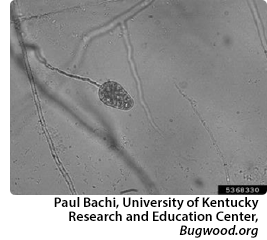Pythium may come from several sources at different times during crop production. Insects common to greenhouses, fungus gnats (Bradysia impatiens) and shoreflies (Scatella stagnalis), excreted viable P. aphanidermatum oospores after ingestion (9). Fungus gnat larvae and shorefly adults may be vectors. Some Pythium species are adapted to live in water producing swimming zoospores that can easily travel to other parts of the greenhouse. Others are adapted to live in the soil producing oospores, which serve as resting structures that survive desiccation and microbial infection. Previous studies suggested that populations of Pythium are relatively stable in soil when optimal conditions are present. Al-Sadi et al. 2008 (2), investigated the potential source of inoculum in greenhouse soils. They found that 7% of fallow soil was infested before introducing it to the greenhouse (2). They also found that other sources of Pythium included potting mixes; soil adhered to cultivation equipment and grower's shoes and reused irrigation pipes. The consensus of opinion is that the main source of Pythium inoculum comes from soil and infected plants introduced to the greenhouse but little work has been done to definitively prove that an isolate found infecting plants is a clone of one found elsewhere in the production system. Pythium species have been found to reside in soil, in aisles, on tools, and in irrigation water (Moorman and Daughtrey, unpublished) but many of the species found are not the main pathogens in greenhouses. Dispersal of Pythium is a major concern in hydroponic culture (15; 19).
Genera Confused with Pythium
For very useful illustrations of the following genera, see Domsch, K. H., Gams, W. and Anderson, T. H. 2007. Compendium of soil fungi. Berchtesgaden, IHW-Verlag (8), available through The American Phytopathological Society (APS).
Phytophthora [Stramenopila, Heterokonta, Peronosporomycetes, Pythiales, Pythiaceae, Phytophthora]
 Some species of Phytophthora can be confused with Pythium and vice versa. In general, they both grow on the same semi-selective media. An important difference is that zoospores differentiate within a thin walled vesicle produced by Pythium sporangia while zoospores of Phytophthora differentiate within the sporangium. In the case of Pythium, this is most easily observed when an isolate is cultured in water on boiled grass blades and the culture is observed using an inverted light microscope. All species of Phytophthora known to date produce more or less lemon-shaped sporangia (shown right). However, some also produce spherical hyphal swellings similar to those formed by some species of Pythium and a thorough examination of cultures is required to find the sporangia.
Some species of Phytophthora can be confused with Pythium and vice versa. In general, they both grow on the same semi-selective media. An important difference is that zoospores differentiate within a thin walled vesicle produced by Pythium sporangia while zoospores of Phytophthora differentiate within the sporangium. In the case of Pythium, this is most easily observed when an isolate is cultured in water on boiled grass blades and the culture is observed using an inverted light microscope. All species of Phytophthora known to date produce more or less lemon-shaped sporangia (shown right). However, some also produce spherical hyphal swellings similar to those formed by some species of Pythium and a thorough examination of cultures is required to find the sporangia.
Aphanomyces [Stramenopila, Heterokonta, Peronosporomycetes, Saprolegniales, Leptolegniaceae, Aphanomyces]
In this genus, the sporangium is a long, inflated, filamentous structure at the end of the hypha. Zoospores form in a single row within the sporangium. When the sporangium breaks open at the tip, encysted zoospores clump there until they form a secondary swimming stage. In Pythium, swimming zoospores are released from a vesicle produced by the sporangium and they quickly swim away if the culture is in liquid. The oospores and antheridia look very much like several species of Pythium.
Pythiogeton [Stramenopila, Heterokonta, Peronosporomycetes, Pythiales, Pythiogetonceae, Phythiogeton]
Most members of this relatively uncommon genus are considered saprophytes by some are plant parasites (3). Morphology is so like Pythium that DNA sequencing will probably be needed to separate the two.
Mortierella [Mycota, Zygomycota, Zygomycetes, Mortierellales, Mortierellaceae, Mortierella]
This is a very common soil borne fungus that produces sporangiospores on branched or unbranched sporangiophores. The sporangiospores look like sporangia of some Pythium species. Some Mortierella species produce zygospores that look like Pythium oospores. Mortierella hyphae are mostly dichotomously branched while Pythium hyphae are not dichotomously branched.

